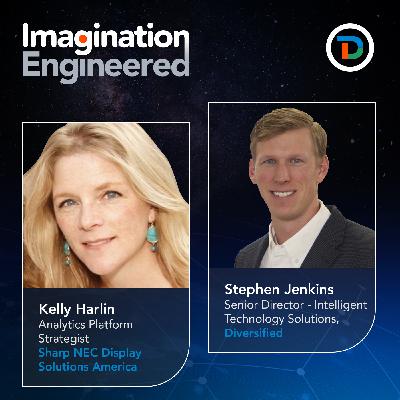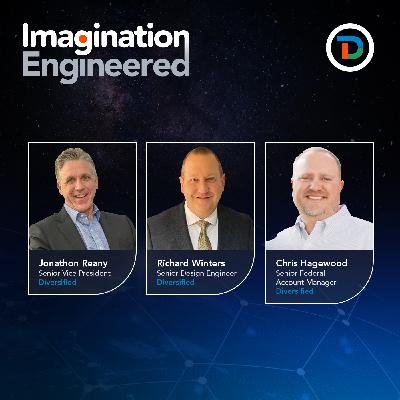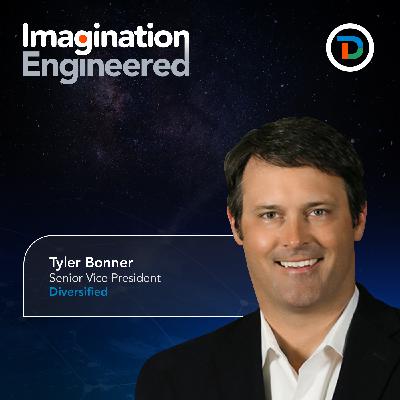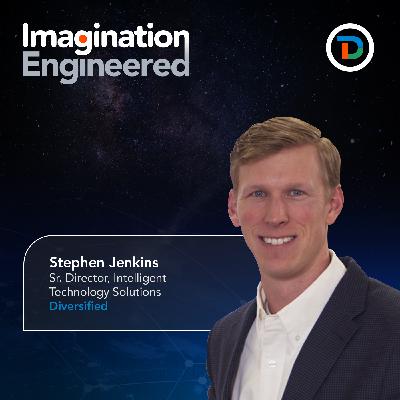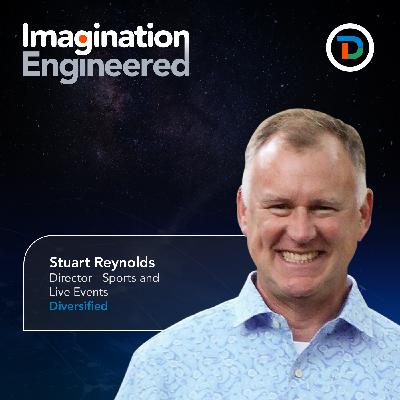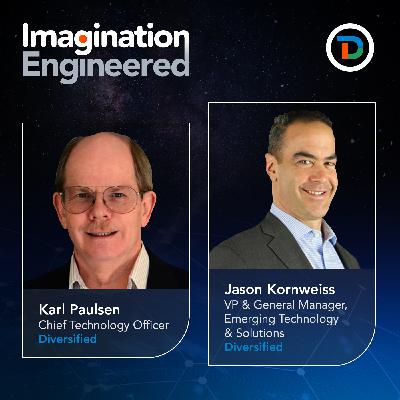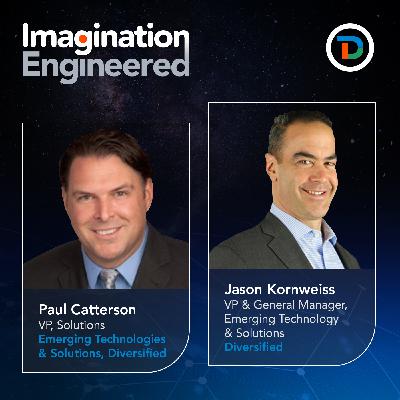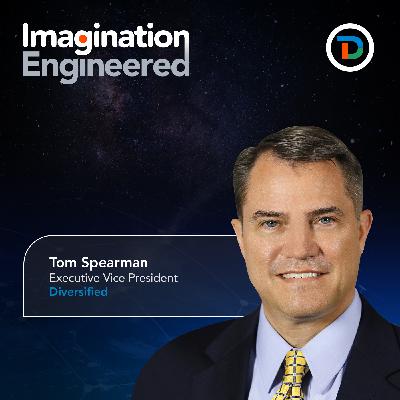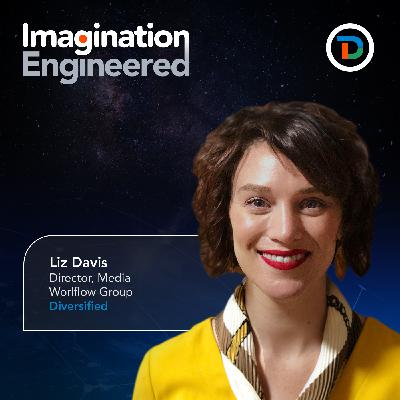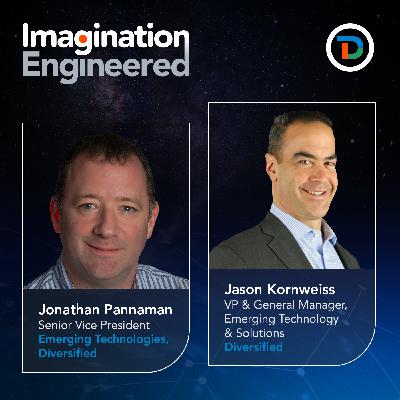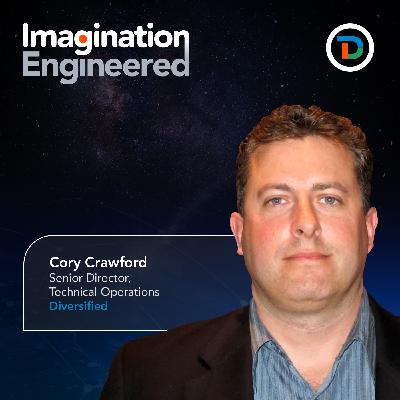Discover Imagination Engineered by Diversified
Imagination Engineered by Diversified

18 Episodes
Reverse
Daniel Litwin, the Voice of B2B, chatted with two AV thought leaders—Karl Paulsen, Chief Technology Officer of Diversified, and Charlie Dunn, Senior Vice President of Tek Video Business Unit from Telestream. Paulsen has been involved in the media and entertainment space since college and now works in systems integration, while Dunn started as an engineer, then moved to the entertainment sector, and has worked with the Tektronix test group for ST 2110 for the past five years. Live media and studio production’s move to IP is a paradigm shift in the evolution of the signal system infrastructure. Since the 2017 introduction of SMPTE’s ST 2110 standard the steady adoption of IP, even through the challenges of COVID, continues. Dunn explained, “The biggest obstacle isn’t so much the technology that’s being deployed, it’s having staff that are transforming from one technology to another.” SDI deployments once centered on good physical layer signals. Today, a different set of critical elements, like packet distribution, is the new domain. “In the old world, system timing was important and straight forward. In the new world, timing became more complicated because it’s a combination of old and new timing elements working together,” he clarified.In SDI facilities, routing control was confined to the router itself and each device was either an SDI source or destination. In an IP infrastructure, the control system communicates with every source and destination, enabled by the NMOS specifications, which harmonizes essential communications. IP will ultimately become a simpler way to set up and manage an infrastructure, but today it’s a layer of complexity that people need to learn. Before IP, studio distribution was a factor based on a fixed size SDI router, which limited its scalability. IP removes those boundaries, adding scalability of undefined dimensions. “In addition to the scaling benefits,” Paulsen explained, “IP enables multiple video formats and resolutions to operate on the same infrastructure. Gone are individual reference systems needed for each format. IP enables a larger and vastly different system architecture.”To learn more about advancements in media production from Paulsen and Dunn, you can visit onediversified.com, telestream.net or connect via LinkedIn.
With students and teachers returning to the classroom, and as businesses debate bringing employees into the office in permanent or hybrid workflows, one thing is sure: safety is still the primary concern. What strategies can schools and businesses use to leverage audio-visual technologies to make these spaces as engaged, interactive, useful, and safe as possible? The good news is that today’s AV technologies offer many great solutions. Anthony Cianfarano, Product Manager for Professional Bravia Displays at Sony, and Todd Alinger, Senior Design Consultant for Audio Visual Environments at Diversified, joined Imagination Engineered to share some fantastic AV strategies and ideas and solutions with host Daniel Litwin.Cianfarano said that Sony’s found the hybrid environment for both work and school will continue to be the trend.“Sony is doing it in our own corporation,” Cianfarano said. “We have limited people in the office, and so I think the needs for both are going to be a separation of space in the office and high-quality remote learning, or remote collaboration, experience. At Sony, we offer the displays or cameras that can produce those high-quality images.”Allinger noted the pandemic created a fluid situation where it is next to impossible to predict a time and place for a total in-person return to school and the office. “It’s not only about having the flexibility to work in an office environment as working from home, but inclusive. That’s a word that we’ve heard a lot now. And that’s making sure that the people working remotely feel like they’re actually in the work environment with those they’re collaborating. So, we leverage technology to bring that real-time inclusiveness to the table with our clients.” And Diversified works to match the AV solution that works best for them.
The pandemic brought many changes to the workplace. But, as workers get vaccinated and offices open back up, how are expectations for collaboration shifting, and how does this affect the technology ecosystem in the meeting room?
IoT products and services are growing, but are the cybersecurity tools and strategies necessary to secure networks from threats posed by these technology innovations growing at the same pace?Two IoT experts from Diversified, Avi Shah, IT Security Engineer, and Adam Bowser, Director of Information Technologies, shared their thoughts on and experiences in keeping networks safe while still taking advantage of all the innovations IoT technology can bring.
The COVID-19 pandemic transformed the landscape of many aspects of life. Still, one of the most noticeable paradigms is the shift in the way education must face the challenges of teaching and engaging students. For higher education, getting it right could mean the difference between staying open or closing doors forever.A podcast panel of experts came together for some straight talk on the situation, sharing experiences solving these challenges during the pandemic and the solutions that have been instituted to get through these uncertain times and better prepare their institutions for the months to come as the pandemic subsides.Mike Berger, IT Manager of Classroom Technology at the University of Tennessee Knoxville, and Jodon Bellofatto, Technology-Enhanced Spaces Lead Analyst at the University of California, Merced, led the discussion from the higher ed side.
During the pandemic, businesses need solutions that can propel them long after COVID-19. Kelly Harlin (embed contributor page), Analytics Platform Strategist at Sharp NEC Display Solutions America, and Stephen Jenkins (embed contributor page), Senior Director of Intelligent Technology Solutions at Diversified, shared their experience with data-driven analytics in IoT solutions.
It’s frustrating when your systems go down, but when you’re the United States Department of Defense, a hardware issue could literally be a matter of life and death.
So, it’s understandable the DOD would have extremely high standards for the products it uses. Vendors have to be sure they’re able to do exactly what they say they can and make sure the products work.
Diversified specializes in building operations centers for mission-critical environments, so it knew what it would take on when it started working on projects with the federal government.
“Those projects were built in such a way where they have zero down time for the most part,” said Richard Winters, Senior Design Engineer. “Something fails here or there, but they have not had a catastrophic failure that causes any kind of vulnerability to the United States. We paid a lot of attention to uptime or MTBF – mean time before failure.”
After impressing out of the gate, Diversified now works with the national government so often it has a dedicated department, the Federal Solutions Group. The group makes sure the technical specifications right and that the relationships are in place for the company to land the highly competitive contracts.
“If you look at our business, it’s very technical, but there’s also the contractual side of the business, especially in the federal government arena,” said Jonathon Reany, Senior Vice President for the Federal Solutions Group. “That is a very difficult part of getting contracts, and over the years, we’ve established relationships with small businesses that have contract vehicles and we’ve established relationships with large businesses that have contract vehicles, so we’re able to utilize just about any of the contract vehicles the Department of Defense and federal government agencies use through our partnerships.”
Between getting the gig and doing it right, Diversified continues to push into new frontiers, already thinking about how their products will change in a socially distant world after the coronavirus pandemic and making sure their customers get a product that works – all the time.
Tyler Bonner, Senior Vice President of Mission Critical Environments for Diversified, joined this episode of MarketScale's Pro AV podcast to break down the building of mission-critical environments for power utility control buildings. Bonner’s 20-plus years in the technical innovation and critical environments field brought an expert’s perspective on the conversation. “Over the past 10-to-12 years, there’s been a migration in the U.S. utility market toward sustainable transmission facilities due to the fact our grid is interconnected,” Bonner said. Consistency in the build of transmission facilities is essential. The distribution side can vary due to the size of some areas - rural communities vs. large cities, for example. No matter the scale of the municipality, it is vital each has infrastructure capable of supporting a 24/7 operation. Different considerations come into play when the environment is a 24/7 operation. If a situation, say a weather emergency, occurs, the building may be used by more people and for a more extended time than in a non-emergency. Noise dampening to ensure people can effectively communicate over the phone, rooms to rest and relax, and areas for different stakeholders to work together without everyone accessing the control room are all factors that go into today’s mission-critical environment designs. Roughly 75% of the projects Bonner works on are remodels. The notable change in these environments, noted Bonner, is the technology.“A lot of these dispatch and transmission facilities have been operating inside the same six walls for 15 years, and the technology changes in the new building brings a culture shift and operational shock for some of them,” he said. A part of every project is training to ensure the people working in the new facility are comfortable using the latest equipment and technology.
AV as a service, or AVaaS, is emerging as a smart way for enterprise customers to take advantage of the latest pro AV technology without the need for continual capital expenditures. AVaaS can also cut down on the need for regular internal training on maintenance and equipment.
Stephen Jenkins, Senior Director of Intelligent Technology Solutions at Diversified, stopped by the Pro AV podcast to speak with James Kent on AVaaS and how it’s paying off for customers who rely on AV for their business.
“As more and more of these AV devices become connected to the network, that opens up the opportunity for proactive monitoring and remote management that allows a service provider to deliver excellent service with guaranteed up times and guaranteed availability,” Jenkins said.
The key to putting together the right AVaaS model is a partnership between client and provider. Jenkins said this is what Diversified does when working with its enterprise customers. They work together to determine the needs and the standards, then a plan is created to accomplish a client’s goals.
“From Diversified’s standpoint, we think service agreements should be built on business outcomes. And that could be unique to someone’s specific business,” Jenkins said. “When you’re on a service agreement, you’re on a predictable monthly payment that includes the hardware, the support, the management and everything. All the AV needs, for say a client’s conference rooms, are taken care of by the service provider. This level of service can be very appealing.”
For the latest news, videos, and podcasts in the Pro AV Industry, be sure to subscribe to our industry publication.
With 4k becoming more readily available in the home, the AV industry is feeling the pressure to create something new in the stadium setting to enhance the live experience. Stuart Reynolds, Director of Sports and Live Events for Diversified, joins host Daniel Litwin to talk about the trends in the industry that are fighting the immersive experience you can get at home and the importance of the production team.
Venues are looking to displays in stadiums to heighten the live experience, and Stuart said that according to surveys, replays, stats, the game in process, history, and player interviews are amongst the most important content that people want to see in stadiums. He said that the social media aspect, like live tweets being displayed, are not as important to stadium goers. Stuart said that people are going to stadiums to be around other people and to be immersed in the event that is happening. He said that one easy way to capture attention is bringing the new fan more information.
Stuart talked about how he is an advocate for HDR being implemented over higher resolutions like 4k displays because at a distance, the human eye won't be able to see individual pixels, making 4k redundant. He said that HDR means better pixels compared to more pixels on a 4k display. Lastly, Stuart talked about the importance of the production team in creating content for the displays and how it is more important than the display technology.
Jason Kornweiss and Karl Paulsen talk about the IP Roadshow, an immersive, two-day technology education curriculum for the media industry.Jason Kornweiss, Vice President and General Manager, Emerging Technology & Solutions, Diversified and Karl Paulsen, Chief Technology Officer, Diversified, joined this episode of the Pro AV podcast to talk about Diversified’s IP roadshow.
The roadshow is a portable IP media lab that serves as an educational tool for the media and AV industry. Kornweiss said there is a massive educational need within media companies today to handle the rapid changes in technology.
“It is difficult, if not impossible, for media companies to be able to refresh their engineering expertise at the rate that technology is moving,” Kornweiss said.
While the IP roadshow began in 2017, for 2020, Diversified plans to make it available, on-site, at customer locations to better help bring people through the new technology standards.
“We’ve done several of these sessions, largely tied to project work,” Kornweiss said. “Customers warmly embraced them and continue to ask for more training and assistance.”
Kornweiss noted that his team would work with customers to provide an IP roadshow tailored to their specific needs.
The roadshow kit now includes materials, demonstrations and hardware from up to 15 different technology vendors. This in-depth approach gives a customer a full understanding of how all of the media technology integrates, and this two-day curriculum is as hands-on as one can get, according to Paulsen.
To learn more about the roadshow or to schedule an on-site demonstration, go to: https://diversifiedus.com/ip-roadshow/.
Businesses have a lot of moving parts to keep track of with streaming over IP, the cloud, machine learning, you name it. But all of that comes with training, education, hiring, and network infrastructures that pose a challenge for even the largest IT and AV teams.
On this new episode of the Pro AV Podcast, host Daniel Litwin sat down with Jason Kornweiss, vice president and general manager for emerging technology and solutions, and Paul Catterson, vice president of solutions for emerging technology and solutions, both of New Jersey-based Diversified. The two future-focused thought leaders share ways to make emerging technologies work more efficiently for you.
When clients approach Diversified as a systems integrator, they often feel behind the times because technology moves so fast. But "technology for technology's sake" isn't always the answer, Catterson said.
"People will come to us saying, everyone's in the cloud; I need to be in the cloud. I need to virtualize; Everybody's virtualizing," he said. "And that may be true to a degree, the true application of that solution is going to be more dependent on what that business is trying to accomplish, not necessarily where it wants to be from a technology standpoint."
Making technology work for your business goals often means outsourcing to managed services that have historically been done in house.
"Clients are more willing than ever to outsource operations [as opposed] to having an on-site staff, which is now quite frankly too expensive to keep that staff trained and fresh with all the latest greatest technologies," Kornweiss said.
Today's office spaces continue to represent a paradigm shift from segmented, non-creative workspaces to the exact opposite. Technology has accelerated this shift towards intimacy and customization, and with that comes the need for the right solutions, particularly for today's communal and meeting spaces.
"We're at a place now where true global room standards are paramount to the success of an enterprise," Tom Spearman, Executive Vice President at Diversified said.
Spearman noted on today's episode of the MarketScale Pro AV Podcast that meeting rooms have changed and expanded in number while shrinking in space. Instead of four, 16-seat rooms, offices are more inclined to create 16 four-seat areas, and the needs of these spaces are very different.
Finding an all-encompassing solution to the diverse layout of offices across the globe will be key to AV integrators, Spearman said. This solution will also have to be compatible with modern expectations of seamless user-experience. This means that neither the completely custom solution nor the one-stop-shop black box solution will be viable; the more successful competitive solutions will need to be technology agnostic and efficient.
"What we're seeing is, where hardwire solutions were the de facto standard for many, many years, I think people have the expectation now that when they walk into a conference room that their first option for connectivity is a wireless presentation gateway," Spearman said. "A hardwire connection falls into the category of their backup connection."
When you think about the amount of content produced regularly, especially from businesses, it’s unlikely that any of it can work seamlessly without a strong software infrastructure. This is especially true for video, and today, expert Liz Davis, Director of the Media Workflow Group for Diversified, joined us on the podcast to share her perspective on how software enables media workflow.
Davis has a long history of working with media and has been in the industry since before the digital revolution. “All brands have become media publishers. It’s more cost-effective than ever. Whereas over a decade ago, many brands still put more investment into traditional media, then they discovered by working with new types of agencies that focused on content creation and began to see lots of return on video. And now, of course, video is everywhere and used in many nontraditional ways,” she said.
Davis shared that many brands still struggle with media workflows, mostly because businesses didn't have the infrastructure initially to pull of the amount of content end-users are now expecting. “Media workflows are both technological and psychological in nature. You have lots of different players that have to work on just one video project—producers, editors, etc. But video has to also have technology behind it for it to meet the goals, whether those be awareness or conversions. Everything needs to be entered into a central repository and have data points attached to them. Software also enables teams to automate non-creative parts of the process,” she said.
She and her team work with many brands on the importance of media. It’s about KPIs and getting the whole team on board to understand the value of this content. But to truly achieve that, the back-end storage and workflow needs to be in place. “Based on the objectives of a brand and the priorities of each department, we create a plan, with budget in mind, to get companies where they want to go,” Davis said.
Listen to Davis explain the critical importance media workflows and the future of software in content production, including machine learning and AI.
Today, the media landscape encompasses thousands of modes of communicating information at lightning speeds -- from the smartphone to the smartwatch, to interactive adverts on streets and in cities. There are, in fact, so many outlets to disperse information that businesses, companies, and corporations are struggling to stay present with the ever-changing information technologies. This is where Diversified comes in. With leading experts in information technology development and years of experience managing large information systems, the team at Diversified is poised to help companies navigate the vast networks of distribution channels today. Jonathan Pannaman, Senior Vice President of Emerging Technologies, and Jason Kornweiss, Vice President and General Manager of Emerging Technologies at Diversified have decades of experience in global media operation. Between the two they have worked for large scale corporations like ESPN and Comcast NBC Universal. Pannaman and Kornweiss bring their expertise to the table to discuss how Diversified is set up to help navigate broadcast infrastructures today, and well into the future. The company summarizes the problem within a greater media ecosystem of products, and develops media plans that get businesses in line with current trends, and sets them up to grow with emerging technologies. As Kornweiss put it, Diversified is a “one hand to shake solution for clients.” In a dizzying world of digital media, this catered approach is invaluable for companies looking to remain current in an increasingly technological world. Listen to Pannaman and Kornweiss breakdown the changing nature of media and the mediums in which its consumed, and how content distributors can stay ahead of consumer trends.
Imagine working for one of the most renowned and influential AV companies in the industry, leading design projects for American icons like the Empire State Building and the Statue of Liberty. It's not a pipe dream; it's the Senior Audio Visual Design Engineer's.
Sound can be a tricky issue at sporting events, and AV professionals must face the challenges of the apparent dichotomy of concert events versus sports venues. On this Pro AV Podcast, two AV veterans from Diversified, Justo Gutierrez and Pete O’Neil, share their perspectives on the special tasks involved in bringing quality sound to sports venues.
The world of collaborative technology in the workplace is growing before our very eyes, and the Pro AV industry is set to capitalize on this in a pretty unprecedented way. Where as before, digital media existed as a tool to entice external viewers, it's now a powerful tool internally as well. Huddle rooms and video conferenceing technology is creating a perfect, authentic medium for digital content to hit employees, and when the technology grows, so does the quality of the content, and vice versa.





